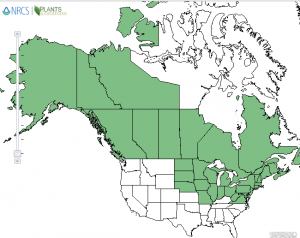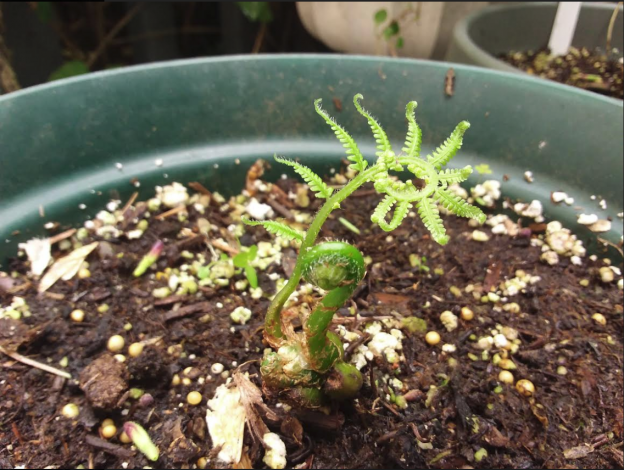Ostrich Fern USDA: The Wood Fern Family—Dryopteridaceae
Newer classification: The Sensitive Fern Family—Onocleaceae
Matteuccia struthiopteris (L.) Todaro
(ma-TOO-kee-uh stroo-thee-OP-ter-is)
Names: The genus is named after Carlo Matteucci an Italian physicist and pioneer in the study of bioelectricity. Struthio is the ostrich genus; pteris means fern— the fronds resemble ostrich feathers. It is also known as Shuttlecock Fern, because of the way the fronds grow in a clump, like the feathery tail of a badminton birdie!
Relationships: Ostrich Fern is the only species in the genus Matteuccia.

Distribution of Ostrich Fern from USDA Plants Database
Distribution: It is found in many of the temperate regions in the northern hemisphere. In North America, it is found throughout much of the northeast and across Canada; but only reaches the west coast in southern Alaska and British Columbia. It is listed as rare, of special concern or vulnerable in Indiana, Rhode Island and New York.
Growth: Sterile, deciduous fronds grow to nearly 6 feet in moist, moderate climates. In less than ideal conditions it is often much shorter, usually 1-5ft. (30-140cm). Ostrich Fern spreads by underground rhizomes to form new crowns and often grows in dense colonies, resistant to destruction by floodwaters.
Habitat: Ostrich Fern is hardy to extreme cold and is most often found in lowland or montane alluvial forests, riverbanks and sandbars.
Diagnostic Characters: The sterile, bright-green fronds grow nearly vertical in vase-like clusters. They are broadest in the middle upper ¼ of the frond and are once-pinnate with deeply cut pinnae. Brown, fertile fronds are shorter (60cm) and narrower, leaf tissue curling over the spore cases; they persist over winter, releasing spores in early spring.
In the Landscape: Ostrich Fern is a popular garden ornamental. Although spectacularly beautiful in the early summer, it may start looking haggard later in the summer, depending on local conditions. It prefers a moist, cool location protected from winds. It is easily propagated by division.
Use by People: The fiddleheads are sometimes eaten raw, or cooked, most notably in Japan; the flavor is sometimes compared to asparagus. As with all ferns, caution is advised, especially consuming raw parts.
Use by Wildlife: It is used as a food plant by the larvae of some moths.
Links:
Consortium of Pacific Northwest Herbaria
E-Flora BC, Electronic Atlas of the Flora of British Columbia
Ladybird Johnson Wildflower Center
Native American Ethnobotany, University of Michigan, Dearborn

